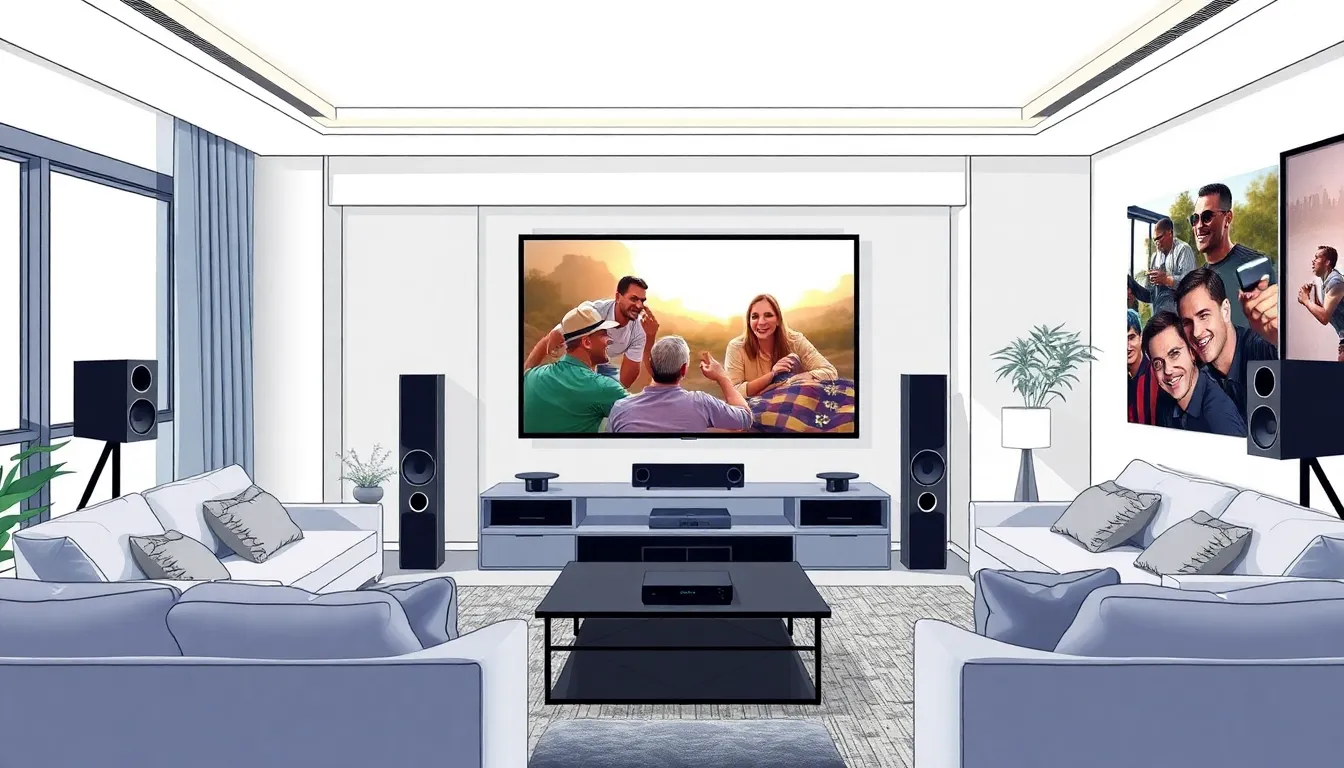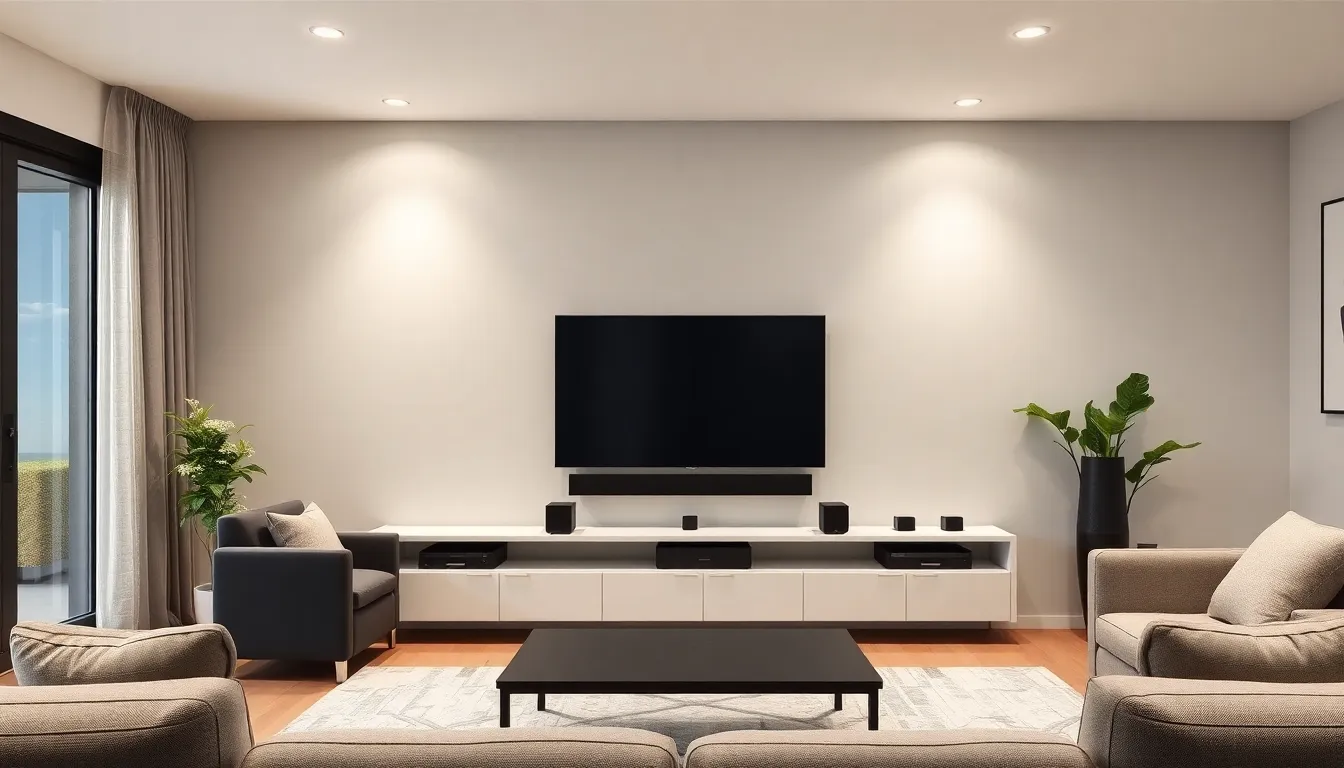Table of Contents
ToggleImagine settling down for movie night, popcorn in hand, and the only wires in sight are those holding the couch together. Welcome to the world of wireless home theaters, where freedom reigns and tangled cords are a thing of the past. With the latest technology at their fingertips, homeowners can transform their living spaces into cinematic experiences without the hassle of a wiring nightmare.
Wireless home theaters offer a sleek, clutter-free setup that doesn’t skimp on sound or picture quality. Whether it’s the heart-pounding action of a blockbuster or the soothing melodies of a concert, these systems deliver an immersive experience that’ll have everyone asking, “Why didn’t we do this sooner?” Get ready to elevate your entertainment game and embrace the future of home cinema—because who wouldn’t want to enjoy a movie without tripping over cables?
Overview of Wireless Home Theater
Wireless home theater systems create an immersive entertainment experience by eliminating messy wiring. These setups rely on wireless technology to transmit audio and video signals, ensuring easy configurations. Users benefit from enhanced flexibility, as they can place speakers and components in optimal locations without being limited by cable length.
Many systems offer high-definition audio formats like Dolby TrueHD and DTS-HD Master Audio, delivering a cinema-like sound experience. Typically, a wireless home theater setup consists of a receiver, speakers, and sometimes a subwoofer, all communicating through Wi-Fi or Bluetooth. Performance remains consistent, with minimal lag or distortion for most applications.
Homeowners appreciate the ease of installation and mobility that wireless systems provide. Placement options increase, allowing for creative arrangements. Some models even support multi-room audio, letting users enjoy their favorite content throughout the house.
The advancements in wireless technology contribute to improved reliability and sound quality. Many brands now incorporate advanced networking protocols, enhancing connectivity and reducing interference. Due to these innovations, users can experience robust signals even in larger living spaces.
Wireless home theaters cater to diverse preferences, offering various feature sets and price points. Budget-conscious consumers can find entry-level options, while high-end systems serve audio enthusiasts seeking superior quality. Given these advantages, it becomes clear why many households gravitate toward adopting wireless home theater solutions for their entertainment needs.
Benefits of Wireless Home Theater

Wireless home theater systems provide several advantages that greatly enhance the viewing experience. These benefits range from aesthetics to flexibility, appealing to a wide array of users.
Improved Aesthetics
Clutter-free environments improve aesthetics in home theaters. Without unsightly cables, spaces appear more organized and inviting. This sleek setup allows homeowners to maintain a modern interior design. Custom installations become simpler, enabling users to achieve a professional look without extensive renovations. Elegantly designed wireless speakers blend seamlessly into any décor. Enhancing visual appeal contributes to a more enjoyable atmosphere for movie watching or gaming.
Enhanced Flexibility
Flexibility stands out as a major benefit of wireless home theater systems. Users position speakers wherever desired without worrying about cord lengths or outlets. This adaptability allows for personalized sound experiences tailored to individual preferences. Rearranging setups for different occasions becomes straightforward, offering variety in viewing or listening environments. Multi-room audio capabilities enhance flexibility, allowing music to flow throughout different areas of a home. Creative arrangements accommodate various room sizes and layouts, maximizing performance and enjoyment.
Key Features to Consider
When selecting a wireless home theater system, specific features play a crucial role in optimizing the experience. Understanding them helps users make informed decisions.
Audio Quality
A top priority involves audio quality. High-definition audio formats like Dolby TrueHD and DTS-HD Master Audio provide immersive sound experiences. Additionally, systems with advanced digital signal processing deliver clearer dialogue and deeper bass. Surround sound capabilities enhance immersion, allowing users to hear environmental sounds from every direction. While selecting speakers, consideration of drivers and frequency response ensures rich audio reproduction. Brands should demonstrate their commitment to audio performance through customer reviews and expert recommendations.
Connectivity Options
Connectivity options significantly impact usability. Most wireless home theater systems use Wi-Fi or Bluetooth to transmit signals, offering flexibility in placement. Systems that support multiple audio sources, such as streaming devices, gaming consoles, and Blu-ray players, provide seamless integration. Users should also check compatibility with smart home ecosystems for integration with voice assistants. Furthermore, robust and reliable connections ensure minimal lag and interruptions. Ensuring that the system includes support for various protocols enhances connectivity and performance throughout different environments.
Popular Wireless Home Theater Systems
Several wireless home theater systems stand out in the market, offering various features tailored to enhance the listening and viewing experience. This section reviews two popular options.
System A Review
System A offers impressive sound quality through its surround sound capabilities. High-definition audio formats like Dolby Atmos create an immersive experience, ideal for movie buffs. Users can easily connect multiple devices via Wi-Fi or Bluetooth, ensuring seamless streaming. Its sleek design complements modern décor, enhancing any home theater’s aesthetic. Setup is straightforward, with few components required. Additionally, this system includes voice control compatibility, allowing integration into smart home ecosystems.
System B Review
System B excels in versatility, featuring a modular design that adapts to different room sizes. Its adaptive sound technology automatically adjusts audio levels based on the environment. This system supports various streaming platforms, ensuring access to an extensive library of content. Users appreciate the user-friendly app, which simplifies control and configuration. Moreover, it includes multi-room capabilities, letting users enjoy synchronized sound throughout the home. Overall, its combination of quality and flexibility makes it a strong contender in the wireless home theater market.
Comparison with Wired Systems
Wireless home theater systems offer distinct advantages over wired counterparts. Flexibility stands out as a primary benefit, allowing users to place speakers without the constraints of cords. Users appreciate the clean aesthetic that wireless setups provide, resulting in a visually appealing environment.
Sound quality also plays a crucial role in this comparison. Many wireless systems support high-definition audio formats like Dolby TrueHD and DTS-HD Master Audio, ensuring rich sound experiences. Wired systems may offer similar audio capabilities, yet users often encounter issues with cable management and limited speaker placement options.
Installation processes differ significantly between the two types. Wireless systems generally require less time and effort to set up, eliminating the need for extensive cabling. In contrast, wired systems often demand professional installation to achieve optimal sound performance.
Connectivity is another area where wireless systems excel. Bluetooth and Wi-Fi technologies provide seamless audio streaming and device compatibility. Wired systems, while reliable, limit users to predefined configurations that can hinder adaptability.
Multi-room audio capabilities enhance the appeal of wireless home theaters. Users can easily expand their systems to provide synchronized sound across various spaces in the home. Wired systems can accomplish this too, but expansion typically involves complicated wiring and additional hardware.
Consideration of both price and performance is essential when comparing these systems. Wireless home theater options generally cater to various budgets, offering more accessible solutions for consumers. Wired systems may deliver superior sound quality at higher price points, emphasizing the importance of individual preferences.
Both types feature pros and cons, making the choice based on specific needs a vital part of the decision-making process. Features like aesthetics, convenience, and audio quality ultimately guide users towards either wireless or wired systems for their home theater experience.
Wireless home theater systems are transforming the way people experience entertainment at home. By eliminating the clutter of wires they offer flexibility in speaker placement and enhance the overall aesthetic of living spaces. With advancements in technology these systems deliver high-quality sound and video that rivals traditional setups.
Homeowners can enjoy the convenience of easy installation and mobility allowing for personalized arrangements that suit their lifestyle. As wireless technology continues to evolve the reliability and performance of these systems only improve. Embracing a wireless home theater setup not only elevates movie nights but also enriches everyday audio experiences throughout the home.



